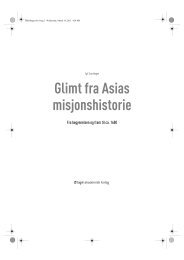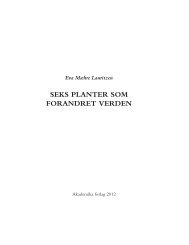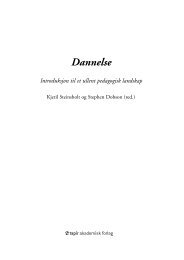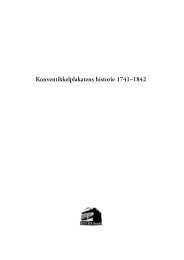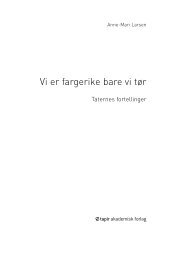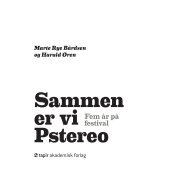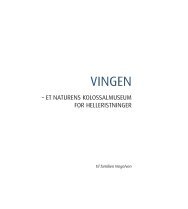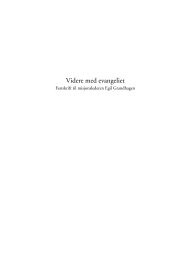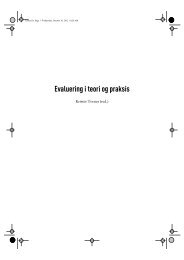Greetings from Spitsbergen Tourists at the ... - Akademika forlag
Greetings from Spitsbergen Tourists at the ... - Akademika forlag
Greetings from Spitsbergen Tourists at the ... - Akademika forlag
Create successful ePaper yourself
Turn your PDF publications into a flip-book with our unique Google optimized e-Paper software.
<strong>Greetings</strong> <strong>from</strong> <strong>Spitsbergen</strong><br />
<strong>Spitsbergen</strong>, <strong>the</strong> largest wilderness in Europe, is as close as you can get<br />
to <strong>the</strong> North Pole. Each year, tens of thousands of visitors experience <strong>the</strong><br />
island’s dram<strong>at</strong>ic landscape with its fragile beauty – fjords, glaciers, packice,<br />
midnight sun, polar bears, reindeer and a fantastic wealth of bird life.<br />
But who were <strong>the</strong> first tourists and how did <strong>the</strong>y reach this uninhabited<br />
“no-man’s land”? <strong>Greetings</strong> <strong>from</strong> <strong>Spitsbergen</strong> traces <strong>the</strong>ir untold story and,<br />
with <strong>the</strong> use of many unpublished photographs and postcards <strong>from</strong> <strong>the</strong><br />
author’s own collection, presents a unique insight into <strong>the</strong> “golden era” of<br />
arctic tourism, which lasted until 1914.<br />
John T. Reilly, Professor of Haem<strong>at</strong>ology <strong>at</strong> <strong>the</strong> University of Sheffield,<br />
has had a life-long interest in <strong>the</strong> arctic and its history, having undertaken<br />
expeditions to Norway, Iceland, Greenland and <strong>Spitsbergen</strong>. He has also<br />
acted as guide to several tourist cruises to Svalbard in <strong>the</strong> 1980s.<br />
www.tapir<strong>forlag</strong>.no<br />
<strong>Greetings</strong> <strong>from</strong> <strong>Spitsbergen</strong> <strong>Tourists</strong> <strong>at</strong> <strong>the</strong> Eternal Ice 1827–1914<br />
<strong>Greetings</strong> <strong>from</strong> <strong>Spitsbergen</strong><br />
<strong>Tourists</strong> <strong>at</strong> <strong>the</strong> Eternal Ice 1827–1914<br />
John T. Reilly
Captain Jørgensen, skipper of <strong>the</strong> “Hertha” in a lighter moment. In 1898<br />
he led a hunting expedition to Franz Josef Land th<strong>at</strong> resulted in <strong>the</strong> kill of<br />
nearly 300 walruses.<br />
A crew member takes sightings off <strong>the</strong> sou<strong>the</strong>rn coast of Franz Josef Land. <strong>Tourists</strong> onboard “Hertha” in <strong>the</strong> pack-ice between Franz Josef Land and<br />
<strong>Spitsbergen</strong>.<br />
A polar bear is spotted on an ice-flow.<br />
82 83
One of four bears killed off <strong>Spitsbergen</strong>’s east coast during <strong>the</strong> 1900 cruise.<br />
The skin’s were highly prized trophies.<br />
One of many seals taken during <strong>the</strong> cruise. The “Stella Polaris” <strong>at</strong> anchor off Hammerfest, 5 th September, 1900. The<br />
“Hertha’s” tourists were invited aboard and were <strong>the</strong> first to hear of <strong>the</strong><br />
expedition’s failure to reach <strong>the</strong> North Pole.<br />
The “Hertha’s” tourists relax in Tromsø, where polar skins were traded.<br />
84 85
Time in <strong>Spitsbergen</strong><br />
Remain in area for approxim<strong>at</strong>ely 5 days<br />
The places to be visited can only be determined on <strong>the</strong><br />
spot and depend on <strong>the</strong> we<strong>at</strong>her conditions. If interested<br />
consider booking <strong>from</strong> <strong>the</strong> following:<br />
- Isfjorden and Sassenbukta (opportunities for priv<strong>at</strong>e<br />
hunting trips).<br />
- Virgohamna and Andrée’s balloon st<strong>at</strong>ion.<br />
- Smeerenburg with its graves and whaling remains<br />
<strong>from</strong> <strong>the</strong> seventeenth century.<br />
- Bellsund and Recherchefjorden (whaling st<strong>at</strong>ion).<br />
- Magdalenefjorden with Adambreen.<br />
If time and we<strong>at</strong>her conditions permit o<strong>the</strong>r sites may<br />
be visited. The final aim is to reach a l<strong>at</strong>itude of 80°N.<br />
At least <strong>the</strong> midnight sun will be seen.<br />
“Oihonna’s” passengers visit Grønfjorden, 1902.<br />
“Oihonna’s” crew and band.<br />
“Oihonna’s” party, 1902. The first French tourists to visit <strong>Spitsbergen</strong>, 1902.<br />
92 93
The “Grosser Kürfurst’s” tourists visit Wellman’s camp on Danskøya.<br />
Krossfjorden and Lilliehöökfjorden. In Möllerfjorden, two<br />
Norwegian hunters requested a passage home, toge<strong>the</strong>r with<br />
<strong>the</strong>ir haul of seal and fox skins, eider down and birds eggs.<br />
They were members of a four-man party th<strong>at</strong> had been sent<br />
to <strong>the</strong> area for two winters by a Tromsø-based company.<br />
Pages have been written about <strong>the</strong> adventures of such hardy<br />
and fearless individuals and <strong>the</strong> names of many have passed<br />
into folklore. Between 1900 and 1910, as many as two<br />
hundred trappers visited <strong>Spitsbergen</strong>, with many seeking<br />
assistance <strong>from</strong> tourist ships to transport stores, deliver mail<br />
or to provide a lift back to <strong>the</strong> mainland.<br />
Adventfjorden was <strong>the</strong> final anchorage for tours after<br />
1908 and <strong>the</strong> stopover provided an opportunity for visitors<br />
to explore <strong>the</strong> mine workings and purchase souvenirs <strong>from</strong><br />
<strong>the</strong> legendary hunter, Klaus Thue. This passing trade must<br />
have been worthwhile, for Thue returned every summer for<br />
over ten years, pitching his tent on <strong>the</strong> shoreline, to sell postcards,<br />
fossils, whale teeth and skins. Cruise ships, however,<br />
were not always welcome, as access to alcohol frequently resulted<br />
in worker drunkenness. Longyear City’s site manager<br />
successfully warned <strong>the</strong> “Grosser Kurfürst’s” crew against<br />
landing alcohol or fire-arms. This was not always <strong>the</strong> case<br />
<strong>Tourists</strong> exploring<br />
<strong>the</strong> shore near <strong>the</strong><br />
Waggonwaybreen’s<br />
snout.<br />
<strong>Tourists</strong> scrambling<br />
on <strong>the</strong> lower slopes of<br />
Gullybreen. Note <strong>the</strong><br />
“Grosser Kurfürst”<br />
anchored in fjord (far<br />
right).<br />
152 153<br />
“Grosser Kurfürst’s” passengers disembarking <strong>at</strong> Möllerfjorden.
Coal Mining and Settlements<br />
The sloop “Gottfried”. The sealing captain Zachariassen was <strong>the</strong> first to<br />
mine coal commercially. In 1862, after being shipwrecked near Kapp<br />
Bohemann, he discovered an exposed coal seam. Returning in 1899 in <strong>the</strong><br />
“Gottfried”, Zachariassen mined a cargo of coal and sold it, partly to <strong>the</strong><br />
tourist hotel <strong>at</strong> Adventfjorden and partly on mainland Norway.<br />
Advent City, <strong>the</strong> world’s nor<strong>the</strong>rnmost town. The <strong>Spitsbergen</strong> Coal and<br />
Trading Company of Sheffield commenced mining on <strong>the</strong> eastern shore<br />
of Adventfjorden in 1904. To support <strong>the</strong>ir activities a settlement was<br />
constructed, consisting of a dozen well-built cabins, th<strong>at</strong> included a store<br />
and bakery.<br />
Advent City boasted <strong>the</strong> first women and horses to be resident in a<br />
<strong>Spitsbergen</strong> mining settlement, 1906. At its busiest, 100 men were<br />
employed, although only one or two vessels were coaled every summer and<br />
exports never exceeded two thousand tons a year.<br />
Advent City’s post office. The mine was not a success, due to competition<br />
<strong>from</strong> <strong>the</strong> more profitable seams around Longyear City, and was abandoned<br />
after a few years.<br />
174 175
Whaling, Grønfjorden. A whaler with a string of blue and fin whales th<strong>at</strong><br />
have been infl<strong>at</strong>ed with air to maintain buoyancy.<br />
Whaling St<strong>at</strong>ion, Grønfjorden. The smell of processing of whales drove<br />
Gerard to write, “it perme<strong>at</strong>es <strong>the</strong> printed page of your book; it nause<strong>at</strong>es<br />
your food; it taints your dreams; and it percol<strong>at</strong>es your prayers”.<br />
A whale c<strong>at</strong>ch being towed to Grønfjorden for processing with an <strong>at</strong>tendant<br />
raft of fulmars and gulls.<br />
Tourist Hotel<br />
The prefabric<strong>at</strong>ed tourist hotel, or lodge, was erected by <strong>the</strong> Vesteraalens<br />
Dampskibsselskab in 1896 and was used during <strong>the</strong> summer months,<br />
1896–1898.<br />
180 181
“Tourist Hotel – <strong>the</strong> world’s nor<strong>the</strong>rnmost Post office”. Note <strong>the</strong> external<br />
stairs th<strong>at</strong> were added during <strong>the</strong> second season.<br />
The hotel (centre left) was moved to Longyear City in 1908, were it was<br />
used as a storeroom and shop until its destruction by <strong>the</strong> German b<strong>at</strong>tleship<br />
“Tirpitz” in 1943, along with <strong>the</strong> rest of <strong>the</strong> settlement.<br />
Andrée’s North Pole Expedition<br />
Andrée’s prefabric<strong>at</strong>ed, wooden balloon hangar was erected on <strong>the</strong> shores of<br />
Danskøya in 1896.<br />
The hydrogen gener<strong>at</strong>or required to infl<strong>at</strong>e <strong>the</strong> balloon. The appar<strong>at</strong>us produced<br />
gas by <strong>the</strong> action of sulphuric acid, diluted with w<strong>at</strong>er, on iron filings.<br />
During <strong>the</strong> first twenty-four hours approxim<strong>at</strong>ely 1,200 cubic metres of<br />
hydrogen was produced.<br />
182 183
Cincinn<strong>at</strong>i (1911) The<br />
17,000-ton, twin-screwed,<br />
“Cincinn<strong>at</strong>i” was built by<br />
F. Schichau of Danzig and<br />
launched on July 14 th 1908.<br />
With a cruising speed of 15.5<br />
knots, she could accommod<strong>at</strong>e<br />
300 first class, 350 second class<br />
and almost 1900 steerage class<br />
passengers while on <strong>the</strong> North<br />
Atlantic route. She lay in Boston<br />
in 1914, was confisc<strong>at</strong>ed by <strong>the</strong><br />
United St<strong>at</strong>es and used as a<br />
troop transporter in 1917 as <strong>the</strong><br />
“Covington”, before being sunk<br />
by a German U-bo<strong>at</strong> (U-86) in<br />
<strong>the</strong> Atlantic off <strong>the</strong> French coast<br />
in 1918.<br />
Victoria Luise (1912–1914). A 16,502-ton steamship, built by A.G.<br />
Vulcan, Stettin in 1900 as <strong>the</strong> “Deutschland”. In 1911, she was rebuilt as<br />
<strong>the</strong> “Victoria Luise” to become <strong>the</strong> largest cruise ship in <strong>the</strong> world, before<br />
being scrapped in 1925.<br />
Fürst Bismarck (1913). The 8,338-ton, 148-metre long steamship was<br />
built by Fairfield Shipbuilding and Engineering Company, Glasgow, in<br />
1905. She went into HAPAG passenger and freight service <strong>from</strong> Hamburg<br />
to Cuba and Mexico in 1906. After being renamed “Friedrichsruh” in<br />
1914, she was laid up in Hamburg and eventually turned over to <strong>the</strong><br />
British in 1919 as war repar<strong>at</strong>ions.<br />
Norddeutscher Lloyd<br />
Grosser Kurfürst (1908–1913). A 13,182-ton, twin-screw, steamer,<br />
built in 1900 by F. Schichau, Danzig. She was 177 metres in length and<br />
had a capacity of 144 first class, 281 second class and 2,373 steerage class<br />
passengers. She was named after Frederich William, <strong>the</strong> “Gre<strong>at</strong> Elector”<br />
(Grosser Kurfürst) who ruled Brandenberg <strong>from</strong> 1640-81.<br />
208 209





